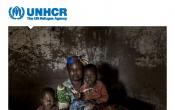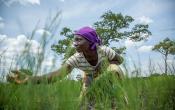Democratic Republic of the Congo Regional Office
Operation: Democratic Republic of the Congo Regional Office
Location
{"longitude":22,"latitude":-4,"zoom_level":5,"iso_codes":"'COD','GAB'"}
By clicking on the icons on the map, additional information is displayed.
Key Figures
| 2017 year-end results | |
| 90% | of Central African primary school-aged children were enrolled in schools |
| 85% | of Burundian primary school-aged children were enrolled in schools |
| 80% | of CAR households were living in adequate dwellings |
| 58% | of primary school-aged children were enrolled in primary education |
| 51% | of South Sudanese households were living in adequate dwellings |
| 1,470 | internally displaced households received core relief items |
| 2018 planning figures | |
| 100% | of the urban refugees will have access to reproductive health and HIV services |
| 80% | of Central African refugee children will be enrolled in primary education |
| 80% | Congolese returnees (18-59 years) will have their own business and/or be self-employed for more than 12 months |
| 5,000 | community sanitary facilities/latrines will be constructed for South Sudanese refugees |
| 2,000 | Central African households will receive multipurpose cash grants or vouchers |
| 3 | schools will receive maintenance support |
Latest Updates and Related Links
People of Concern
23%
Increase in
2016
2016
| 2016 | 3,321,847 |
| 2015 | 2,701,921 |
| 2014 | 3,619,785 |

[["Refugees",452887],["Asylum-seekers",3236],["IDPs",2232900],["Returned IDPs",619600],["Returned refugees",13224]]
Loading ...
Democratic Republic of the Congo Regional Office
< Back
2017
{"categories":[2013,2014,2015,2016,2017,2018],"budget":[196.62741826,196.1200685,207.82899884,209.71033616,234.31289884,200.97890137],"expenditure":[80.44026164,82.89793508,81.24654248,73.23818483,88.617526,null]}
{"categories":[2013,2014,2015,2016,2017,2018],"p1":[84.29544165,71.90779198,91.41104086,103.12806996,136.71162641,109.91443737],"p2":[1.76370934,1.64748057,2.69677526,1.923405,1.94889796,1.28578031],"p3":[24.57256446,47.12909081,38.54665211,29.81920304,29.873246,11.1438503],"p4":[85.99570281,75.43570514,75.17453061,74.83965816,65.77912847,78.63483339]}
{"categories":[2013,2014,2015,2016,2017,2018],"p1":[48.3141246,50.09923907,57.35459999,58.9382084,65.13414131,null],"p2":[1.40268682,0.79246867,0.72133408,0.36397887,0.48065037,null],"p3":[12.22476921,16.65508797,10.2698795,3.24760875,3.79706059,null],"p4":[18.49868101,15.35113937,12.90072891,10.68838881,19.20567373,null]}
Loading ...
CHOOSE A YEAR
- 2014
- 2015
- 2016
- 2017
- 2018
The 2017 Year-End Report will be available shortly.
Working environment
The volatile security situation in eastern Democratic Republic of the Congo (DRC) in late 2016 was further compounded by the delay of the Presidential elections. The ongoing climate of instability in parts of the country could pose serious challenges to UNHCR’s ability to implement the required level of protection and assistance for people of concern in 2017. Military operations in the Kivu region and localized conflicts with armed groups are expected to continue in 2017. Developments in neighbouring countries such as South Sudan and Burundi may also lead to further refugee influxes.The Government of DRC is providing land for the establishment of refugee camps, as well as contributing to the security in the camps, civil status documentation and registration exercises. Refugee children are able to enroll in schools.
Key priorities
In 2017, UNHCR’s protection strategy will continue to be oriented towards durable solutions while ensuring the centrality of protection in all interventions. The strategy will focus on building self-reliance, with a view to empowering people of concern while strengthening the resilience of entire communities.In 2017, UNHCR’s operation will focus specifically on:
• multi-sectoral assistance to camp-based refugees alongside the promotion of alternatives to camps;
• building self-reliance by supporting livelihood opportunities for refugees and host communities;
• facilitating durable solutions, including voluntary returns of refugees in DRC and of Congolese refugees in neighbouring countries.
• Protection monitoring, prevention of and response to SGBV and search for durable solutions for the 1.7 million IDPs in the country.
In the event of a funding shortfall in 2017, primary education for both people of concern and host communities, provision of transitional shelters, medical assistance to SGBV victims, and provision of production kits to people of concern will be affected.



